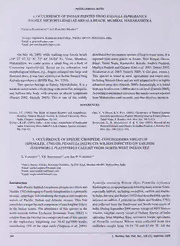
Occurrence of Indian Painted Frog Kaloula Taprobanica (Family Microhylidae) At Arnala Beach, Mumbai, Maharashtra PDF
Preview Occurrence of Indian Painted Frog Kaloula Taprobanica (Family Microhylidae) At Arnala Beach, Mumbai, Maharashtra
A . MISCELLANEOUS NOTES 4. OCCURRENCE OF INDIAN PAINTED FROG KALOULA TAPROBAN1C (FAMILY MICROHYLIDAE)ATARNALA BEACH, MUMBAI, MAHARASHTRA Pritesh Nandvikar1-2and Parveen Shaikh13 'ZoologyDepartment, RamnarainRuiaCollege, Mumbai400019, Maharashtra, India. Email: n_pritesh@yahoo.com ’Email: parveen.shiekh@yhaoo.co.in On July 16, 2009, while walking near Amala beach distributedbutuncommonspeciesoffroginmanyareas. Itis (19° 27’ 07.32" N; 72° 44' 54.64" E), Virar, Mumbai, reported from many places in Assam, West Bengal, Orissa, Maharashtra, we came across a small frog on a bark of Bihar, Tamil Nadu, Karnataka, Kerala, Andhra Pradesh, Casuarina equisetifolia. Based on its coloration and MadhyaPradesh andGujarat(Giri etal. 2001 Daniel 2002; ; morphological features, e.g., fingers enlarged into large and Sivakumar et al. 2003; Daniels 2005; V. Giri pers. comm.). flatteneddiscs, it was lateridentifiedas Indian PaintedFrog This species is found in rural, agricultural and forest area, Kaloula taprobanica (BNHS Reg. No. 5250). includingWesternGhatsandarewelladaptedtoliveinhighly This species belongs to Family Microhylidae. It is a urbanized areas also (Daniels 2005). Interestingly, it is found m medium-sized(adults<6cm)frogwithsnoutflat,triangular, fromsea-leveltoover 1,000 abovesealevel(Daniels2005). and balloon-like body with obscure or absent tympanum Accordingtomentionedreferencesthisspecieswasnotreported (Daniel 2002; Daniels 2005). This is one of the widely from Maharashtrauntil recently,andthusdeserves attention. REFERENCES Daniel, J.C. (2002): The Book of Indian Reptiles and Amphibians. Giri, V., V. Hegde & V. Patil (2001): Occurrence ofPainted Kaloula Bombay Natural History Society & Oxford University Press, Kalolulataprobanica(FamilyMicrohylidae)atPointCalimere, India. Chapter:Amphibians, Pp.181. Tamil Nadu.J. BombayNat. Hist. Soc. 98(1):121. Daniels, R.J.R.(2005): India-Alifescape.AmphibiansofPeninsular Sivakumar, S., R. Manakadan, S. & V. Giri (2003): Record of the India.UniversityPressIndiaPvt.Ltd.Chapter:Speciesaccounts. PaintedKalolulataprobanicainAndhraPradesh.J.BombayNat. Pp. 118-121. Hist. Soc. 100(2&3): 631 OCCURRENCE OF EPIZOIC CIRRIPEDE, CONCHODERMA VIRGATUM 5. (SPENGLER, 1790) ON PENNELLA INSTRUCTA WILSON INFECTED ON SAILFISH ISTIOPHORUS PLATYPTERUS CAUGHT FROM NORTH-WEST INDIAN EEZ S. Varghese1’2, V.S. Somvanshi13 and Sijo P. Varghese1'4 'FisherySurveyofIndia, BotawalaChambers, SirP.M. Road, Mumbai400001,Maharashtra, India. Email: santhavarghese@hotmail.com ’Email: somvanshi@rediffmail.com Email: varghesefsi@hotmail.com Introduction Pennella instructa Wilson (Syn. Pennella zeylanica Indo-PacificSailfishIstiophorusplatypterus(Shawand Kirtisinghe)isacopepodparasiteinfectingmanymarinefishes, Nodder 1792)belongingtoFamilyIstiophoridaeisaprimarily especially billfish, including swordfish, sailfish and marlin. oceanic,epipelagicfish inhabitingthetropical andtemperate InIndia,DevarajandBennet(1972)haddescribedthisspecies waters of Pacific, Indian and Atlantic oceans. This fish infested on sailfish, /. platypterus (Shaw and Nodder, 1792) constitutesamajorbycatchcomponentoftunalonglinefishery and collected from the South-east and South-west coasts of in the Indian waters. The abundance of this species in the India. DuringSeptember2006surveyvoyageofMFVMatsya north-western Indian Exclusive Economic Zone (EEZ) is Vrushti, longline survey vessel of Fishery Survey of India evidentfromthefactthatanaveragecatchrateofthisspecies operating from Mumbai Base, seventeen female specimens in the exploratory longlining was 39.42 kg/1000 hooks, of Pennella instructa Wilson were collected from two constituting 15% of the total catch (Varghese et al. 2004). sailfishes caught from 18-19 °N and 67-69 °E. All the 344 J. Bombay Nat. Hist. Soc., 106 (3), Sept-Dec 2009
